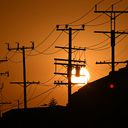California's worst-ever September heat wave tests power grid

California's worst-ever September heat wave is putting the state's electricity grid through a big test. It held up Tuesday evening, with no rolling blackouts despite an all-time record high power demand of 52,061 megawatts.
Why it matters: Heat waves are becoming more intense, more frequent and longer lasting due to human-caused climate change, and such events are stressing our energy infrastructure in new ways.
The big picture: California is seeking to move rapidly off fossil fuels, having just passed a slew of climate-related measures, including a ban on internal combustion engine-powered vehicles beginning in 2035.
- A large-scale grid failure during an unprecedented heat wave could call into question the state's progressive policy agenda, including its overall energy transition strategy.
- In addition, it could create political headaches for Governor Gavin Newsom (D), a politician with national ambitions.
- California's grid operator sought to avoid a repeat of rolling outages in August 2020, affecting about 800,000 homes and businesses, instead aiming for smaller interruptions if needed.
Zoom in: Since that event two years ago, California has moved to add generating capacity and battery storage as well as put in place electricity import agreements from nearby states.
- Much of the additional generating capacity that has been switched on is powered by natural gas.
- The state is seeking cleaner options to call on in coming years, including deals for battery storage that can release renewably-generated power into the grid during peak times.
- The California ISO, which operates the state's grid, has leaned on these strategies the past few days. In addition, the state has spotlighted demand-side measures to cut electricity use during peak use periods, between about 4 and 9 p.m. local time.
- The California ISO has implemented eight straight Flex Alerts to call for energy conservation from its customers, such as pre-cooling homes and then turning thermostats up to 78°F during peak use.
Of note: One particular text alert from the California Office of Emergency Services, delivered to cell phones Tuesday evening, had a near-immediate effect on lowering electricity demand in the state. It warned of impending rolling outages if energy use stayed too high.
Between the lines: In its "root cause analysis" of the 2020 outages, officials concluded that climate change impacts require speeding up the incorporation of better grid planning and more electricity generation.
- Climate scientists said there is little doubt that climate change is worsening the current heat wave.
- "We really don’t need to attribute most heatwaves individually anymore. The answer is always the same, we made them hotter," Michael Wehner, a climate researcher at the Lawrence Berkeley National Laboratory, told Axios via email.
- Wehner tweeted that this heat wave is about 3 to 5°F hotter than it would have been in the absence of human-caused greenhouse gas emissions.
- "For heat waves there’s absolutely no question whether climate change played a role, all heat waves have been made more likely and more intense, how much more depends on exact location," said Friederike Otto, a leading scientist working on extreme event attribution at Imperial College London, told Axios via email.
- She said that the rate of change in extreme heat events is a key factor in determining the societal impacts. "How fast are hot extremes getting worse with global warming and can our adaptation keep up with it?" she said.
The bottom line: The question of whether we can keep adapting our infrastructure to the shifting climate is likely to keep California power officials up at night long after this heat wave ends.